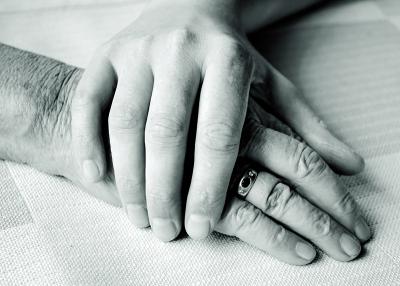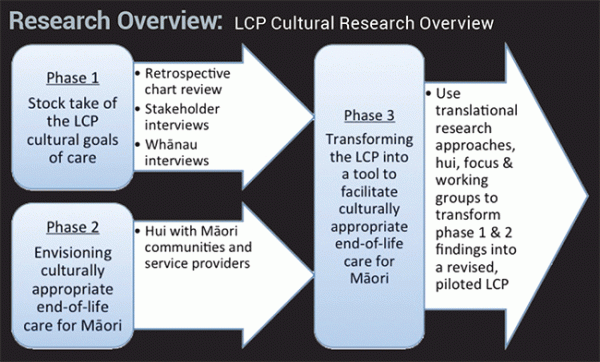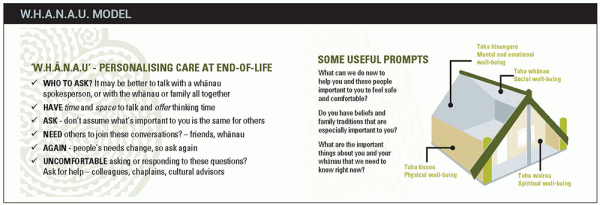LEARNING OBJECTIVES
- Reading and reflecting on this article will enable you to:
- Recognise the significance of assessing and responding to individual needs during EOL care.
- Discuss the influence of ethnicity and culture in EOL care.
- Reflect on common barriers to assessment.
- Formulate assessment strategies and approaches for identifying what is important to individual patients and their families during EOL care.
 Maria, a newly registered nurse working in a medical ward, is already behind in her work when she is allocated a patient for admission, Henare. Just sixty years old, Henare has metastatic lung cancer, and it is believed that he has only a few days to live. He may soon be transferred to the hospice, but for now Maria, needs to complete his nursing assessment, and start his end-of-life (EOL) plan.
Maria, a newly registered nurse working in a medical ward, is already behind in her work when she is allocated a patient for admission, Henare. Just sixty years old, Henare has metastatic lung cancer, and it is believed that he has only a few days to live. He may soon be transferred to the hospice, but for now Maria, needs to complete his nursing assessment, and start his end-of-life (EOL) plan.
Henare’s admission form indicates he identifies as Māori. While Maria feels reasonably confident about assessing his physical needs, she is not so comfortable when it comes to assessing cultural or spiritual needs.
“You know when I see ‘culture’ on the assessment form, I sort of feel this little handbrake go on. I just think, ‘I don’t want to go there.”
While she knows she is expected to complete all nursing sections of the EOL plan Maria is trying to keep her questions to a minimum, as Henare is sleepy and his wife upset. Maria is also keen to get off duty promptly at the end of her shift.
Maria quickly looks for a cultural resource book that will tell her what Māori patients need, but she can’t find anything. She then recalls another Māori patient who was dying, and the specific customs and traditions (tikanga) that were important to him and his family. Maria decides that as Henare is also Māori she can record those same interventions in the ‘cultural needs’ section of his care plan.
This scenario was developed from recent New Zealand research relating to EOL care. One of the key research findings was that nurses need support and education in assessing and addressing cultural goals during palliative care. This article outlines some of the factors that influence cultural needs assessment and strategies to help nurses develop confidence and competence in ensuring that the needs of individuals, their family, and whānau are identified and met.
Researching cultural goals
The Liverpool Care Pathway (LCP) was an internationally-accepted, widely-used clinical tool designed to improve the delivery of EOL care for all. During its introduction to New Zealand, a decision was made to add ‘cultural goals’ to the LCP (versions 11 & 12) to ensure cultural needs were comprehensively assessed and addressed for all patients, and specifically for Māori1. ‘Cultural goals’ focused on the patient being given the opportunity to identify their cultural needs, and ongoing assessment that cultural needs were recorded, referred to, reviewed as necessary, and respected. The cultural needs of relative(s) or carer(s) were also included.
Research (funded by the Health Research Council and approved by the Central Ethics Committee) was then undertaken to explore how the LCP was being utilised and how it could be strengthened to facilitate culturally appropriate care for Māori1.
A retrospective audit of 100 LCP charts, completed between 2009 and 2011, identified little documentation related to cultural goals, and even less about whether these goals had been met. Forty stakeholders were also interviewed, and hui held with 70 members of Māori communities and service providers1.
The researchers revealed that although the importance of cultural goals was widely acknowledged, a range of factors impeded the provision of culturally appropriate, individualised care. This included the cultural diversity of staff (and patients) holding divergent and sometimes incompatible beliefs about death and dying, organisational constraints impacting on service delivery, and staff not feeling safe in addressing this topic. The assessment of cultural needs was considered especially problematic, partly because of perceived sensitivities around the word ‘culture’, but also because staff were unclear about how to even begin these discussions.
The cultural context of care

Recent international events2 related to the LCP are now being reflected in new approaches to EOL care-planning in New Zealand, but the need for individualised care, based on comprehensive assessment, has not changed. As well as the personal impact on the individual recipient of care, nurses have legal and professional responsibilities3,4,5 to ensure the cultural appropriateness of the services they provide.
The importance of effective communication in clinical decision-making and the provision of quality EOL care is well established6. Nursing literature also reveals ongoing difficulties related to assessment of individual needs at EOL and the cross-cultural considerations inherent in care provision7,8,9,10.
Ethnicity is just one aspect of cultural identity, but New Zealand’s ethnic diversity is increasing. The 2013 census figures revealed the four main ethnic groups are European (74 per cent), Māori (14.9 per cent), Pacific peoples (7.4 per cent) and Asian (11.8 per cent)11. One quarter of our population was born overseas, and our most common languages are English, Māori, Samoan, and Hindi. There may be diverse cultural beliefs, values, traditions, practices, and languages within and across all groups of carers involved in EOL care12. It is essential that nurses are sensitive to these differences and identify what is important to each individual patient, their family and whānau.
What happens if we get it wrong?
Coyle13 reminds us “it is during EOL care that nurses make decisions that will become memorialised by the patient and family”. Failing to establish what is most important for the patient and their family and whānau may result in a sense of loss of control, increase anxiety and stress levels, and diminish personal dignity. Sometimes it can be the little things that cause distress, and are remembered years later. For example, in our study a whānau had been fastidious in maintaining their father’s personal hygiene prior to his hospitalisation:
“Every time we came to the hospital, something wasn’t going right. His washing – because he could only be bathed in bed, he couldn’t be in the shower – his toes and feet weren’t being washed. They weren’t looking in his drawers for his socks, clean socks, which the whānau brought in every day. I thought maybe they had forgotten to bring them in, but no, they were all there, he had seven pairs of unused socks there.”
In another instance, the whānau, convinced their father would deteriorate even further if he stayed in hospital, knew they needed to get him home. While they saw this as a priority, slow hospital processes meant it took eight days to get him there.
What happens when we get it right?
Providing culturally appropriate care means knowing what is important to that individual, and their family and whānau, and working with them to ensure their needs are met. Done well, it is a process that not only empowers individuals and their families but also can be a source of great satisfaction for staff, as this recollection from a nurse working in residential aged care illustrates:
Rebekah, a 76-year old Māori widow, came to live in our rest home and hospital three years ago. It’s still unusual to find Māori living in residential aged care, but all Rebekah’s children now live in Australia and she didn’t want to leave New Zealand. Rebekah was in frequent contact with her family, and loved talking to us about them, especially her mokopuna (grandchildren).
Rebekah was admitted to the public hospital when her chronic renal failure worsened. A week later, Rebekah was told that no further treatment was possible, and she had only a few more days of life. Rebekah said she wanted to come back home to us to die. By now, all her children and some of her extended whānau had arrived.
“There’s a lot of emotion at times when they come to understand that they’re about to lose a person that they love. For whatever reason and however big or small the family is, the reality is that they just want to be given the opportunity to do it their way.”
We were aware her whānau had certain protocols to follow, but we weren’t sure exactly what these were.
“The charge nurse said “you tell us what you want done, if we’re not doing, following the protocols or whatever” and we had a really moving, learning, experience through until she died. There was a large group of them [whānau], and we worked in together; we just worked side by side caring for her.”
Once, when she was semi-conscious, Rebekah began to get upset. The whānau who were with her began singing a waiata (song).
“Before they started to sing, she had this look of sheer terror on her face, but as they started singing, you could see the peace coming back.”
Four days later, Rebekah died. Most of her whānau were there, two of her mokopuna stroking her hands, her daughter lying on the bed, cuddling her:
“Her sister was singing one of the old songs from when they were kids. There was a lot of singing and praying (karakia). It was a very emotional time, very moving.”
Rebekah’s daughters washed her and dressed her. The family asked if Rebekah could come back here from the undertakers. So Rebekah returned to us for another 24 hours, in the coffin decorated by her mokopuna. Residents and staff were able to say goodbye. She was never alone, there was always one of the whānau sitting with her, holding her hand, and keeping her spirit calm until she left for her marae.
“It’s not just caring for the resident. It’s caring for everyone. It’s understanding that there’s more to this resident than just them. You’re trying to meet as best you can whatever needs the family have and the resident themselves. Emotionally, spiritually, physically, the whole holistic picture.”
Comprehensive, ongoing assessment and the rapport between staff and Rebekah and her whānau were fundamental in ensuring their needs were acknowledged and addressed.
Strategies for assessing cultural needs.

A number of our research participants had the same request:
“And if there was, you know, that ‘wave your wand’ little handbook that said you can perhaps approach the questions in this manner or that manner, or you can use this phrase or that phrase, that might be quite helpful.”
Unfortunately, there isn’t one magic question that will open the floodgates of information about cultural needs. What works with one family won’t necessarily work with another, and as needs change during the dying process, previously successful communication strategies may suddenly prove ineffective.
Contemporary cultures are dynamic, diverse, and multifaceted, as are the individuals who identify with those cultures. Assuming that all members of a cultural group will have the same needs and goals (as demonstrated in the scenario at the beginning of this article) is a major barrier to the provision of individualised care. ‘Cultural checklists’ may just reinforce stereotypes. An awareness of common cultural practices can, however, help sensitise nurses to aspects of care that may require more in-depth assessment.
The W.H.A.N.A.U model (see box above) was developed from the research findings and is currently being piloted. It is one approach that can be used to guide the assessment of cultural needs for Māori. It is also relevant to all cultures. It includes several conversation starter questions that may help get assessments underway, and assessment principles. Regardless of the way that nurses chose to start these sensitive conversations, basic principles of good communication are also fundamental14.
Developing confidence and competence in assessing cultural needs requires a conscious effort on the part of the nurse, driven by a genuine commitment to ensuring that individualised care is provided. There must be a willingness to reflect on personal communication competencies, including attentive listening, and a commitment to establishing and maintaining a rapport with the family and whānau. Nurses are not expected to know everything, and sometimes just listening is as important. Remember, too, that people of all cultures value kindness and respect. When further support is required, consider approaching colleagues, chaplains and cultural advisors.
Conclusion:
Assessing cultural needs is an essential component of all nursing practice, which is particularly significant during EOL care. Nurses can find these assessments difficult, especially when the patient and family are from a culture with values very different to their own. Developing cultural assessment skills requires a conscious effort on the part of the nurse, underpinned by a commitment to individualised care. The last thing we want is patients, families, or whānau saying “but I didn’t want that!”
Download the learning activity here>>
About the authors:
Lesley Batten, RN PhD, Marian Bland, RN PhD, and Maureen Holdaway, RN PhD, are all experienced nurses and researchers, working in the Research Centre for Māori Health & Development, Massey University, Palmerston North.
The LCP research team is a partnership between the Research Centre for Māori Health and Development, Massey University, Arohanui Hospice, the-then National LCP Office, and Te Wakahuia, Manawatu Trust, Palmerston North. Researchers include Dr Simon Allan, Clare Randall,
Dr Jean Clark, Bridget Marshall, and Delwyn Te Oka.
This article was peer reviewed by:
Tess Moeke-Maxwell RN PhD, research fellow at the University of Auckland.
Wayne Naylor RN BSc(Hons) PGCert (palliative care) Director of Nursing, Hospice Waikato.
Recommended resources:
Useful websites
The Conversation Project (Institute for Healthcare Improvement) focuses on advance care planning. Their Conversation Starter kit has some great tips for starting sensitive discussions. Link here.
A New Zealand film on advance care planning (‘Living for today, planning for tomorrow’, PRN films 2013) illustrates individual illness experiences, and the communication strategies that health professionals use for ongoing, sensitive conversations. Link here.
Recommended reading
BPACNZ (2006) Providing palliative care to Māori. Available from here.
Includes suggested approaches for clinicians in cross-cultural consultations.
MOEKE-MAXWELL T (2014). What whānau need at the end of life. Kai Tiaki 20(4), 12-14. and ELDRIDGE V (2014). Whānau respond to tangihanga and grief. Kai Tiaki 20(4), 15-1712-14.
Resources to guide reflection on, and understanding of, respectful and culturally sensitive nursing care for whānau at the end of life.
SCHWASS M (2005). Last words: approaches to death in New Zealand’s cultures and faiths. Wellington: Bridget Williams Books with The Funeral Directors Association of New Zealand.
A resource on the traditions and practices of a range of cultures and faiths that can provide some hints about what may need to be explored further with the patient and their family.
STALLWORTHY E & GLAVISH R (in press) Cultural considerations when providing care to New Zealand Māori. Nephrology. doi:10.1111/nep.12081.
Includes a summary of the Whare Tapa Whā model, and outlines some specific Maori cultural practices.
WALKER R (1990) Ka whawhai tonu matou: Struggle without end. Auckland: Penguin Books (NZ).
Useful for developing a deeper understanding of Māori identity and the social construction of whānau within New Zealand today.
References:
1. BATTEN L, HOLDAWAY M &THE LCP RESEARCH TEAM (2012) Culturally appropriate end-of-life care for Ma -ori. Technical report for Phase 1b: Stakeholders’ perspectives of the cultural goals of care in the Liverpool Care Pathway for the dying patient (HRC11/027). Report No 2. Research Centre for Māori Health and Development, Massey University, Palmerston North
2. NEUBERGER J, GUTHRIE C, AARONOVITCH D ET AL (2013) More care, less pathway: A review of the Liverpool Care Pathway. Department of Health UK. Link here.
3. HEALTH AND DISABILITY COMMISSIONER (1996) Health and disability services code of consumer rights. Link here.
4. NURSING COUNCIL OF NEW ZEALAND (2012) Code of conduct for nurses. Link here.
5. NURSING COUNCIL OF NEW ZEALAND (2011) Guidelines for cultural safety, the Treaty of Waitangi, and Ma -ori health in nursing education and practice. Link here.
6. CLOUGHLIN N (2013) Calling time: communication challenges for health professionals involved in end-of-life clinical decision-making and care provision. Nursing Review November, RRR.
7. WILLIAMSON M & HARRISON L (2010) Providing culturally appropriate care: a literature review. International Journal of Nursing Studies 47, 761-769.
8. MCCLELLAND H (2013) Editorial: powerful questions in clinical practice. International Emergency Nursing 21,1-2.
9. MITCHELL D (2008) Spiritual and cultural issues at the end of life. Medicine 36(2), 109-110.
10. CAREY S & COSGROVE J (2006) Cultural issues surrounding end-of-life care. Current Anaesthesia & Critical Care 17, 263-270.
11. STATISTICS NEW ZEALAND (2013) 2013 Census quickstats about national highlights: cultural diversity. Link here.
12. FORREST L (2013) Supportive cancer care at the end of life: mapping the cultural landscape in palliative care and music therapy. Music and Medicine. 3(1), 10-14.
13. COYLE N (2013). Foreword. In WITTENBERG-LYES E, GOLDSMITH J, FERRELL B & RAGAN S Communication in palliative nursing (pp vii-viii). New York: Oxford University Press (p.vii).
14. BACK A, ARNOLD R & TULSKY J (2009) Mastering communication with seriously ill patients: balancing honesty with empathy and hope. New York: Cambridge University Press.
THE HOUR OF POWER: Assessing cultural needs during end of life care
Reading the article and undertaking this learning activity is equivalent to 60 minutes of professional development























